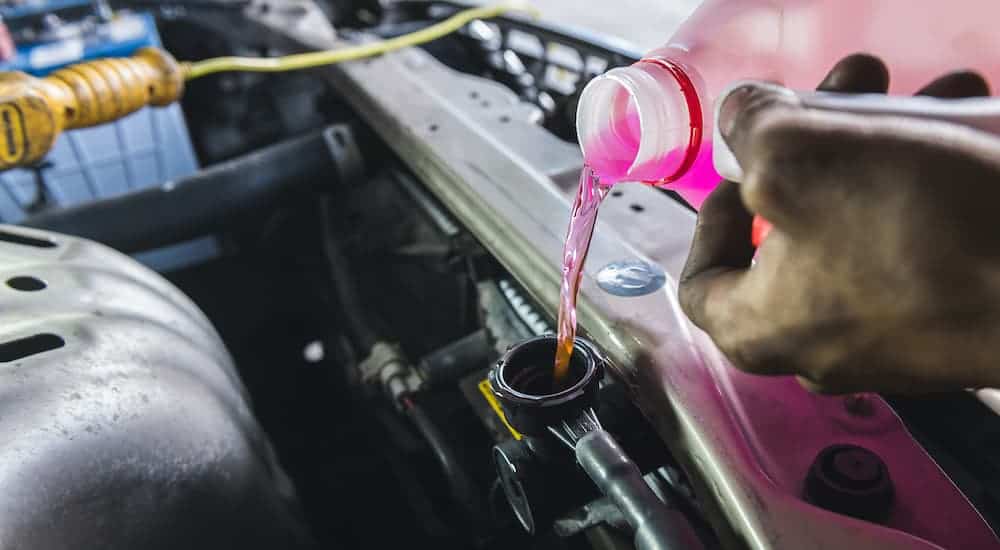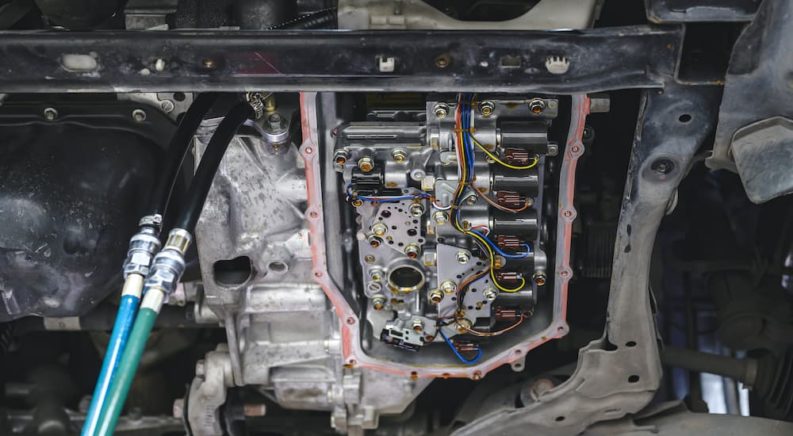Virtually anyone who’s ever driven a car knows that fluid refills and changes are essential car ownership tasks. After all, you’re not going anywhere without filling the gas tank, and most people are familiar with the need for periodic oil changes. But you could be forgiven for not realizing that this only scratches the surface of all the fluids that are required to keep your car running smoothly. For example, did you know that you should change the transmission fluid in a Chevy Traverse every 45,000 miles under severe driving conditions? If you’re looking at a used Chevy Traverse or any other used car, consider this and other maintenance intervals before you commit to a purchase.
We’ll cover many of the different fluid types that require attention in your vehicle. The Chevy Traverse will be used as an example for recommended maintenance intervals, but most of these maintenance items will be applicable to any modern SUV. It’s always smart to check your owner’s manual and talk to a trusted mechanic about services you’re thinking about for your vehicle, but this is a great place to start!
Gearbox Fluid
The term “gearbox” is here used to cover the transmission, differentials, and transfer case. You probably know that the transmission contains the various drive gears – on the Chevy Traverse and most other modern cars, the computer shifts gears automatically depending on speed and throttle inputs. Every vehicle also has front and rear differentials, which split power between the left and right wheels and allow them to spin at different speeds, an essential feature for turning without wearing down the tires. Finally, all-wheel drive vehicles have a center differential or transfer case to deliver power to the rear axle.
All these devices contain gears spinning at high speeds and transferring huge amounts of force. Filling each with lubricating fluid is essential to prolonging the life of these precise, expensive components. Unlike gas or oil, gearbox fluid won’t get burned away – low fluid levels are signs of leaking and require immediate attention. Otherwise, the fluid will serve you well for a very long time – in fact, Chevy only recommends changing the differential fluid every 150,000 miles under moderate driving conditions. However, third-party sources will usually recommend changing transmission, differential, and transfer case fluids at around 100,000 miles.
All sources agree that this interval is different for vehicles that experience “severe driving conditions.” Severe driving conditions demand that the gears work harder than usual and subject them to excess wear. Some examples include towing and hauling, frequent stop-and-go driving, extreme temperatures, or dirty and dusty roads. In these conditions, the fluids will get polluted with debris that needs to be periodically removed – almost universally suggested to be 45,000 miles for transmission, differential, and transfer case fluids. Talk with your mechanic about whether your driving conditions qualify as “severe” so they can take proper care of your vehicle.
Engine Coolant / Radiator Fluid
Keeping your engine cool is critical to preventing damage, and having a supply of fresh coolant is the only way to make that happen. Engine coolant draws heat out of the engine and disperses it to fresh air in the radiator. This fluid also needs to include an antifreeze component for vehicles in cold climates for year-round operation.
Over time, contaminants in the system can build up and clog the lines, preventing the radiator system from working properly. To prevent this, Traverse owners are recommended to have the coolant flushed and replaced every 150,000 miles or every 5 years, whichever comes first.
That’s a long time to go without servicing a very important component. To make sure you’re not leaking coolant, ensure that the engine coolant level gets checked at every regular maintenance interval – every 7,500 miles for the Traverse.

Brake Fluid
The brake system on modern vehicles uses hydraulic (liquid) pressure to squeeze the pads to the rotors. The most common issues with brake fluid involve air pockets that create a spongy response as the bubbles compress during braking. Used Chevy Traverse owners are generally recommended to have a certified technician bleed and replace the brake fluid every 3 years or 45,000 miles to prevent this, whichever comes first.
Air Conditioning Refrigerant
Air conditioning systems work by using the warm air in your vehicle to cause a refrigerant fluid to boil, compressing the boiled vapor to make it much hotter, then using the outside air to cool the vapor until it condenses back into a liquid. These systems can spring leaks, and even if they don’t, the refrigerant can break down and lose effectiveness over time. While there’s no specific interval for replacing it, if you ever feel like your cold air isn’t cold enough, ask your mechanic for an AC service that’ll identify any leaks and ensure that you get topped up with fresh refrigerant.
Wiper Fluid
Bugs be gone! Windshield wiper fluid is essential for keeping your line of sight clear, whether it’s bugs, dust, salty spray, or anything else smearing across your windshield. Like gasoline, over time, the reservoir is emptied out and needs to be topped off. Chevy recommends checking the level at every gas stop and service visit just to make sure you don’t run out when it counts. To that end, it’s not a bad idea to keep a fresh bottle and funnel in the trunk, especially in the winter, when salty roads demand a lot of windshield wiping. It’s important to use wiper fluid rated for low temperatures in cool climates, so look for ratings of -20 degrees or lower if that applies to you.
Power Steering Fluid
The Chevy Traverse is a great example for power steering maintenance because the two generations use the two most common systems you will find in a modern vehicle. The 2018 and later Chevy Traverse makes use of electric power steering, which employs a small electric motor to help turn the steering rack. This system does not require power steering fluid to function.
However, 2017 and older models use traditional hydraulic power steering that does require power steering fluid. Curiously, Chevy Traverse manuals don’t mention power steering maintenance, and third-party recommendations vary wildly – from 30,000-60,000 miles, up to 75,000-100,000 miles. In general, you will not need to replace or top off power steering fluid regularly, but pay close attention to your steering feel to catch problems before they become serious.
Oil
We already admitted that most folks know they need to change the oil now and then, but you may not be sure how often to do so. You can safely go past the old standards of 3,000 or 5,000 miles, providing you use modern full synthetic oil. Chevy recommends inspecting and changing the oil every 7,500 miles or once a year on the Traverse. If the oil is still clean at the 7,500-mile inspection by a certified technician, they’ll allow up to 12,000 miles before mandating a change, but the 1-year limit still applies. Oil breaks down over time, so no matter how gentle you are with your ride, oil changes are still essential. An additional tip – before leaving your car idle for 30 days or more, have the oil changed to clear out sludge and debris that could settle and jam up your engine during the idle time.

Gasoline
Obviously, you need to top up the gas tank now and then, or you won’t be going anywhere. Actually, this piece of advice is another one for when you intend to leave the car parked for a while. Cars don’t like to sit idle for long, and there’s a lot more to do to prep for such events than we can cover here, but one thing you can do to protect your fuel system before you leave it idle for 30 days or more is to fill it up. An idle gas tank is vulnerable to water condensation and related corrosion – a full tank leaves nowhere for the water to go, thereby protecting it from damage.
Conclusion
There’s a lot of fluids inside your car, be it a Chevy Traverse or any other model. Combustion, drivetrain lubrication, steering, braking, cooling, and windshield wiping all depend on consumable fluids to perform the way they do. A regular maintenance check-up every 7,500 miles, as Chevy recommends for the Traverse, is a great time to check on all these systems to make sure nothing’s low, leaking, or dirty.
While some fluids are consumed quickly, like gasoline, oil, and wiper fluid, other fluids will last for several years and 100,000 miles or more before they need to be replaced. Those fluids are critically important even though we don’t need to think about them often, so be sure to make calendar reminders to schedule maintenance visits to replace them and keep your ride running happily for many years to come!

